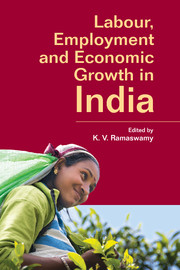Book contents
- Frontmatter
- Dedication
- Contents
- List of Tables and Figures
- Preface
- Part 1 Economic Growth and Employment
- 1 Introduction and Review of Issues
- 2 India's Labour Market during the 2000s
- 3 Services-led Growth and Employment in India
- 4 Growth, Structural Change and Poverty Reduction
- 5 Age Structure Transition, Population Ageing and Economic Growth
- 6 Labour Intensity in Indian Manufacturing
- 7 Gender Discrimination in Manufacturing Employment in India, 1999-2009
- Part 2 Employment and Labour Law
- Contributors
- Index
6 - Labour Intensity in Indian Manufacturing
from Part 1 - Economic Growth and Employment
Published online by Cambridge University Press: 05 June 2015
- Frontmatter
- Dedication
- Contents
- List of Tables and Figures
- Preface
- Part 1 Economic Growth and Employment
- 1 Introduction and Review of Issues
- 2 India's Labour Market during the 2000s
- 3 Services-led Growth and Employment in India
- 4 Growth, Structural Change and Poverty Reduction
- 5 Age Structure Transition, Population Ageing and Economic Growth
- 6 Labour Intensity in Indian Manufacturing
- 7 Gender Discrimination in Manufacturing Employment in India, 1999-2009
- Part 2 Employment and Labour Law
- Contributors
- Index
Summary
Introduction
India's disappointing performance in labour-intensive manufacturing is one of the compelling and least understood aspects of India's post-reform economic development (Kochhar, et al. 2006; Joshi, 2010). Given the large numbers of surplus labour in low productivity agriculture in India, the expectation was with the economic reforms of 1991, and the removal (at least in part) of existing distortions in factor and capital markets, India's structure of production would shift more towards labour-intensive sectors, and there would be an increase in labour-intensity across the board in Indian manufacturing. Yet as Hasan et al. (2013) show, India uses more capital-intensive techniques of production than countries at similar levels of development. More surprisingly, controlling for factor prices, India specializes in more capital-intensive varieties within broad industry groups than the United States, which is a much more capital- abundant country.
In this chapter, we analyse the patterns and determinants of labour-intensity in Indian manufacturing. To do this, we need to know which industries can be classified as labour-intensive and which cannot be. We propose and implement a simple method of classifying industries by labour-intensity. Using this classification, we examine broad trends and patterns in labour-intensity (that is, the ratio of workers to fixed capital stock) in the sectors we identify from 1980– 81 to 2009–10. We then examine possible determinants of the growth of labour- intensive sectors in Indian manufacturing using states as units of analysis. But first, we begin with a discussion of the overall phenomenon of jobless growth in India, and locate the issue of the weak performance of the labour-intensive manufacturing industries within this wider phenomenon.
Phenomenon of jobless growth in India
India has witnessed the fastest rates of economic growth since the 1991 economic reforms in its post-independence period. However, this process of economic growth has not been job creating. The employment elasticity of output – the per cent increase in employment for a 1 per cent increase in GDP – has fallen from 0.40 in 1983–1993 to 0.29 in 1993–2004.
- Type
- Chapter
- Information
- Labour, Employment and Economic Growth in India , pp. 153 - 180Publisher: Cambridge University PressPrint publication year: 2015



